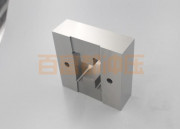What are the fastening methods of mold parts?
3. Riveting method: open a groove on the punch along the outer contour, determine the groove depth according to the working conditions of the die, then put the die into the fixing plate, and finally squeeze the punch around the punch with the fixing plate material.
4. Heat sleeve method: The cooperation between the mold sleeve and the concave mold adopts a large amount of interference. When the connection of the interference fit only plays a fixed role, the amount of interference should be less, and when the connection increases the prestress, the amount of interference should be large.
5. Welding method: It is mainly used for the equipment of cemented carbide convex and concave mold. The solder is brass, and it is cooled slowly after welding.
6. Low melting point alloy method: Low melting point alloy refers to the volume expansion during condensation, and uses this characteristic to fix parts.
7. Epoxy resin bonding method: After hardening, it has strong adhesion to metals and non-metals, high connection strength, good chemical stability, small shrinkage, and simple bonding method. However, the hardness is low, and it is not resistant to high temperature, generally lower than 100 degrees.
8. Inorganic bonding method: copper oxide powder is quantitatively mixed with aluminum hydroxide phosphoric acid solution, which has high bonding strength and good wear resistance, but has poor impact ability and is not resistant to acid and alkali.
Read More →







